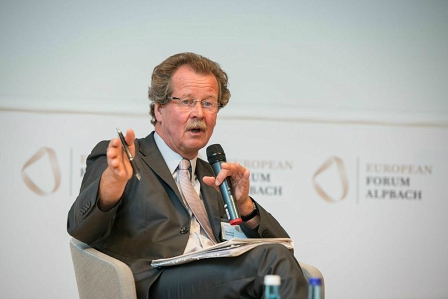Erstellt am: 22. 8. 2014 - 11:14 Uhr
To Drone Or Not To Drone
150 years ago today the First Geneva Convention was signed with the aim of forming "the basis on which rest the rules of international law for the protection of the victims of armed conflicts."
A century and a half on, although the treaty has been updated several times, we're still grappling with the rules of war. And the use of drones is one of the most controversial issues.
Michael W. Lewis is a fan of the use of drone attacks as a military tactic. He calls it the “most discriminating form of warfare.” Drone attacks kill less civilians, he claims, than other forms of weaponry.
Lewis, a former fighter pilot who flew missions in the first Gulf War, cites independent investigatory figures from the drone-critical Bureau of Investigative Journalism that estimate the civilian casualties of the attacks in the past three years at around 3%, a figure Lewis describes as “extraordinarily low”.

Philipp Naderer / European Forum Alpbach
The use of drones dominated the debate at the law symposium at the European Forum Alpbach in Tyrol yesterday.
This is important not just ethically but also tactically. Military commanders know that civilian casualties have a radicalizing effect. A botched attack is a recruiting tool for more terrorists. “Every time you kill the wrong person, it is likely that the rest of their family will join radical extremists,” says Lewis.
He contrasts a high-tech drone strike with a traditional special forces capture operation when there is a lot of metal flying around. “When 20 or 30 heavily armed men are hammering bullets towards another 20 or 30 heavily armed militants, often in proximity to civilians, there is a much greater potential for civilian casualties.”
A recent special forces assault on a militant base in Somalia was called off for exactly that reason. A drone with a single missile and a 20 pound warhead, argues Lewis, only endangers people "within 10 metres of the target.”
"The procedures have changed"
The 3% figure that Lewis quotes stems from the post 2011 period. Before that date, Lewis admits, the civilian casualty record for drones was much worse and it was the early days of “collateral damage” that have shaped our negative perceptions of drone violence.
“The procedures that are used have now changed”, says Lewis. During the height of the Afghanistan campaign in 2009, US General Stanley McChrystal asked a study group to find ways to minimize the civilian casualties.
The group was tasked with analyzing every civilian casualty in Afghanistan, figuring out why they happened and then coming up with a protocol of how to prevent future casualties.
The tactics were changed from compound strikes, where family or unarmed friends might be hit, to vehicle strikes. He says protocol demands that the targets are under constant surveillance for at least 72 hours to counteract the danger that poor intelligence has identified a false target.

Philipp Naderer / European Forum Alpbach
Renowned human rights lawyer Manfred Nowak agrees that drones can often be less harmful to civilians, but he says that “the problem arises if drones are used to target individuals outside hostilities; outside the situation of an armed conflict." The US says it is fighting a transnational conflict with Al Qaeda and the Taliban. "This sort of war is unlimited. Wherever those groups go, whether it is in Yemen, Pakistan, Somalia or, in principle, even in Austria.”
Novak says that this interpretation of war undermines the post-Second World War agreement that the use of force was absolutely forbidden apart from in a few clearly defined exceptions, for example the blessing of the UN Security Council.
"Unable or Unwilling"
But Lewis says it is a question of dealing with “the unable or unwilling”. Clearly the US would not use a drone attack on Austrian territory. If there were a terror suspect on Austrian soil it would simply ask the Austrian authorities to detain that suspect. The US, he says, would not demand the suspect be handed over to US authorities, it would just demand that he or she wasn’t allowed to use Austrian territory to launch attacks on Americans.
The Afghan government has given the US permission to use drones of its territory and so has, apparently, the government in Iraq. But nobody was asked in Somalia, while Pakistan has strongly criticized US drone attacks on its sovereign territory. But both those states, argues Lewis, fall into the “unable or unwilling” category. “If Pakistani territory is used to launch attacks against American across the border in Afghanistan, Pakistan has a duty to prevent that happening. If they don’t discharge that duty, which is part of their sovereignty, then the US has the right to respond.”

Philipp Naderer / European Forum Alpbach
Nowak remains skeptical. He says drone attacks on militants on the immediate Pakistani border could be justified by the concept of “preemptive self defense,” but he insists that drone use has to remain the exception not the rule. If Washington can ask Austria to arrest terrorists, it should be able to ask Yemen to do the same thing. Instead it flying drones all over Yemen, killing suspected militants without trial.
“Of course, President Saleh of Yemen has given the US a sort of permission. But according to international law you would have to justify every single killing. Can any President simply authorize that any people in his country are killed without any sort of court proceedings? The rule of law is suffering very much in this sort of situation.”
The Need For Urgency
But international law moves slowly while events move very fast. Nowak suspects that drones have already been used in northern Iraq against Islamic State militants. Those militants had been surrounding a mountain and threatening Yazidi civilians with a choice between murder and dehydration as the world watched on in horror and frustration. With such urgency isn’t it better that we don’t have to wait for court judgments?
Nowak says he supports the US action, invited by the Iraqi government, to protect civilians although he wishes that they had sought a Security Council ruling: “I am not sure in this instance that Russia and China wouldn’t have agreed in this particular situation.”

Chris Cummins
Isn’t it all a question of interpretation? Let’s take a hypothetical situation. What if Russia, where the media describes the pro-west government in Kiev as “fascist”, decides to label Ukrainian soldiers “terrorists”? Would Russia, following US example, be entitled to carry out drone attacks on Ukrainian soil?
“No,” insists Lewis, “Because Ukrainians are not crossing the border into Russia and killing Russians. But there are Al Qaeda fighters who are crossing the Pakistani border into Afghanistan.” He says it is the same situation as Israeli special forces crossing into Lebanon to target Hezbollah militants.
Clearly Defined Rules Of Engagement
More Drones
Neue "Transformer"- Drohnen für die US-Militärs: Der Bau der ersten Protoypen eines futuristischen autonomen Helikopter-Flugsystems der militärischen Forschungsagentur DARPA ist angelaufen. (10.8.2014)
EU-Drohnenprogramme werden ausgebaut: Der aktuelle Bericht der britischen Bürgerrechtsorganisation Statewatch kritisiert die als Forschungsförderung getarnte EU-Subventionspolitik für Rüstungskonzerne (12.02.2014)
What we need are clearly defined rules of engagement and Nowak points out that the European Parliament is pushing for such an agreement but the differences in positions remain apparently unbridgeable. “Yet it is such an important issue we really need international consensus on when drones can be used and when not.”
Nowak also complains about a lack of transparency and accountability. “Everything is so secret. Israel never accepts it is using drones. The US is a little more open but the CIA is not transparent at all."

Chris Cummins
But isn’t there a danger that we have entered a dangerous era of video-game warfare? We’ve come a long way of course from the days of hand-to-hand combat with axes. War has been highly technological for decades. Yet killing someone from the comfort of an office sometimes situated thousands of miles from the target seems to have crossed an ethical line.
For the first time, you can kill without risking any personal danger. Hasn’t that made killing too easy? Too cheap?
“One of the most irresponsible and disappointing things I have read in recent years was the UN report talking about a 'PlayStation' mentality. It suggested that drone operators did not take the taking of human lives very seriously. In fact the very opposite is true. As I mentioned, operators follow their intended targets for at least 72 hours and often for a week or more. They get to know more about the people they are killing than have any warriors in the history of mankind. Then, if after seeing their targets go home to their kids and eating meals with their friends, they also see them planting bombs or doing things that put them on the targeting list, they follow them up a road one day and kill them. You have to see the consequences of your work. Drone operators suffer higher levels of post-combat stress than many combat units."


